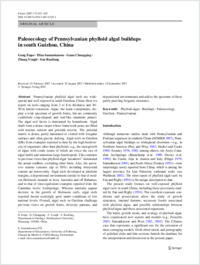Paleoecology of Pennsylvanian phylloid algal buildups in south Guizhou, China
- Enpu, Gong Department of Geology, Northeastern University, Shenyang, China
- Samankassou, Elias Department of Geosciences, University of Fribourg, Switzerland
- Changqing, Guan Department of Geology, Northeastern University, Shenyang, China
- Yongli, Zhang Department of Geology, Northeastern University, Shenyang, China -
- Baoliang, Sun Department of Geology, Northeastern University, Shenyang, China
-
12.09.2007
Published in:
- Facies. - 2007, vol. 53, no. 4, p. 615-623
English
Pennsylvanian phylloid algal reefs are widespread and well exposed in south Guizhou, China. Here we report on reefs ranging from 2 to 8 m thickness and 30–50 m lateral extension. Algae, the main components, display a wide spectrum of growth forms, but are commonly cyathiform (cup-shaped) and leaf-like (undulate plates). The algal reef facies is dominated by boundstone. Algal thalli form a dense carpet whose framework pores are filled with marine cement and peloidal micrite. The peloidal matrix is dense, partly laminated or clotted with irregular surfaces and often gravity defying. Algal reefs in Guizhou differ from examples reported to date by the high biodiversity of organisms other than phylloids: e.g., the intergrowth of algae with corals (some of which are twice the size of algal thalli) and numerous large brachiopods. This contrasts to previous views that phylloid algal “meadows” dominated the actual seafloor, excluding other biota. Also, the pervasive marine cements (up to 50%) including botryoidal cement are noteworthy. Algal reefs developed at platform margins, a depositional environment similar to that of modern Halimeda mounds in Java, Australia and off Bahamas, and to that of time- equivalent examples reported from the Canadian Arctic Archipelago. Whereas nutrients appear decisive in the growth of Halimeda reefs, algal reefs reported herein seemingly grew under conditions of low nutrient levels. Overall, algal reefs in Guizhou challenge previous views on growth forms, diversity patterns, and depositional environments and add to the spectrum of these partly puzzling biogenic structures.
- Faculty
- Faculté des sciences et de médecine
- Department
- Département de Géosciences
- Language
-
- English
- Classification
- Geology
- License
-
License undefined
- Identifiers
-
- RERO DOC 8364
- DOI 10.1007/s10347-007-0122-4
- Persistent URL
- https://folia.unifr.ch/unifr/documents/300531
Statistics
Document views: 137
File downloads:
- Document: 193
